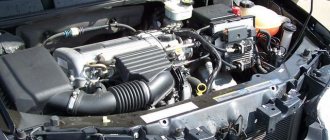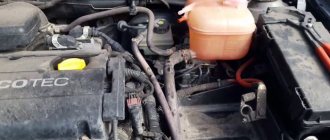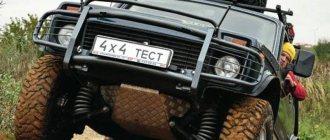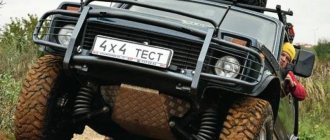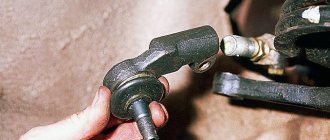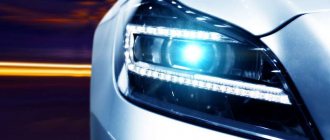Having received a driver's license and bought a car, it is worth driving for some time on not very busy roads and practicing parking in places where this action can be done as simply as possible. This must be done not only because you still have too little driving experience, but also because you need to get used to your new iron friend and feel the dimensions of the car. At this stage, many people wonder how to feel the dimensions of the car if I am a beginner. It is the sense of size that allows you to perform any maneuvers without violating your own and others’ safety.
Recommendations and tips: how to feel the dimensions of a car.
Dimensions
The concept of dimensions usually refers to the height, length and width of the car. But the machine is not only in a static position; it also has dynamic dimensions. Those who have carefully studied in a driving school know that there are six main indicators:
- A straight line that continues the wheels – left and right.
- Continuation line of the front bumper.
- Rear bumper.
- Front axle.
- Rear axle.
These parameters are completely different for different brands and not only beginners, but also quite experienced drivers need to get used to them. You can feel them well only after some time has passed - this is the experience of traveling in this particular car. Only after feeling his car, the driver can easily fit into a dense traffic flow or park in a very small and inconvenient space. The same feeling allows you to avoid bumps on the road or move on rough terrain. It’s quite easy to spot a novice driving; many of them try to crane their necks during the trip and try to look at the road in front of the bumper. Such drivers can often see various minor damage to the bumper, front and rear, or headlights. All this is most often the result of unsuccessful parking. You can try to avoid this, because even minor repairs often cost a very tidy sum.
Exercises to develop lateral dimensions
It’s better to start with this simple exercise - to develop a sense of lateral dimensions. An inept driver either shivers too much sideways in response to a sudden situation, or leans too hard sideways, and as a result, “tears off the ears” of his car. Having learned to understand the size of his car, the driver may notice that it is not at all necessary to shy away into the next lane. To practice the skill, you will need a spacious area, preferably paved. You will need two sticks or branches, 150-170 cm long, they will need to be wrapped in something bright. For example, adhesive tape with white and red markings will come in handy. We step back 2 cm from the edge of the mirror and place sticks on both sides of the car. As a result, it looks like a gate through which you need to squeeze. You need to start practicing the exercise at minimum speeds, literally 10-15 km/h. At this speed you need to pass the target, then turn around and increase your speed a little. Gradually increasing the speed by 5-10 km/h, you need to reach the mark of 90-100 km/h - at this speed the field of view is narrowed almost to the maximum. It’s stronger only on Formula 1 cars. After successfully achieving the maximum, it is worth returning to this exercise sometimes in order to maintain the skill.
Exercises to develop front and rear dimensions
Everything here is much simpler, the procedure is the same as in a driving school. The same two sticks with a bright designation will be used. All the driver needs to do is place one pole at the front bumper and the second at the rear. And, like in a driving school, drive up front and back to the poles so that, through trial and error, you learn to determine where the contact zone begins. It is recommended to do the same thing in the dark by touching the rear bumper - in low light the picture in the mirror is distorted. The exercise should be performed at minimum speed - be careful not to damage the paintwork.
Exercises to develop a sense of the edge of a car
The body angle often suffers from “scratching” against walls, cars, fences and curbs. There is nothing surprising about this - modern cars with sloping hoods and swollen bumpers. You can, of course, hang an oversized mustache based on KrAZ drivers or hipster VAZ classics, but this option is not suitable for everyone. But everything can be compensated by feeling the trajectory along which the corner of the bumper moves. The exercise is very simple. The task is to simulate a turn in a narrow block. To do this, one pole is installed in an arbitrary place - it will imitate the internal extreme point. You should start by simulating a left turn, because in this case the right corner of the car is the farthest from the driver. Therefore, the first pole will simulate the inside corner of the fence when turning left, and the second pole will simulate the possible point of contact of the bumper with the fence, curb or wall. The driver drives up to the first pole and begins to make a left turn. After several “sighting” turns, the dimensions of the corridor narrow and become similar to real conditions. The closer the second pole is to the trajectory of the bumper angle, the better. After all, the more difficult training conditions a driver puts himself in, the faster and better he will learn to drive a car. You can find out all the most interesting and relevant things on our website quality21.
Developing a sense of size
For a good driver, the feeling of the car occurs automatically, as if subconsciously, and the goal of any beginner is to achieve exactly this level. To the question of how a beginner can get used to the size, the answer is clear - you need to not be lazy and do some self-preparation. Experienced motorists and driving instructors talk about several groups of possible complexes:
- Completing a complex of individual, or self-guided, training using improvised or stationary means.
- Individual preparatory work on the car.
- Completing training using assistive electronic devices.
Why do you need to feel the dimensions of a car?
A driver who does not feel the dimensions of his car will inevitably hit the curbs and risk getting into an accident the first time he enters a road with heavy traffic. There are few practical lessons completed during training at a driving school, so it is advisable to do some additional training immediately after receiving your license. The dimensions of the machine are divided into 2 types:
- static - basic parameters of the car (length, width and height);
- dynamic - the distance from the edge of the hood and trunk to the obstacle.
While static values are always constant, dynamic values are not. The driver determines them approximately, so it is very important to learn how to do this accurately. As a result, parking, overtaking, changing lanes or driving around will not cause any problems. You can feel the size of a car only by practicing regularly. Moreover, when driving in reverse, it is more difficult to do this than when driving forward.
Individual car preparation
The adequacy of driving will depend on how comfortable, and most importantly, how correctly the driver sits behind the wheel. Proper seating reduces unnecessary driver movements and speeds up the decision-making process. This is achieved due to the fact that the driver has the correct position of his arms and legs, and in addition, sufficient visibility, without unnecessary bending and peeking. To achieve the optimal fit, the driver needs to make a special adjustment. Adjusting the driver's seat and steering wheel
- Sit in the driver's seat and adjust it just for you. Ideally, you need to fully depress the clutch and move the seat forward or backward so that it is comfortable and there is no desire to stretch. The backrest is adjustable so that when using your legs you do not have to move your entire body.
- Do the same with the steering wheel - your palm should fit between the rim of the steering wheel and your knees, and at the same time the second hand should be extended above the steering wheel and touch its top point with your wrist.
Learning to park a car confidently: how to learn to feel the dimensions
Many novice motorists try to avoid parking in reverse because they are afraid that they will not be able to perform this maneuver correctly and will damage their or someone else’s car. Most often, such fears are associated with the fact that the driver is simply not yet accustomed to the dimensions of his car.
Of course, you can solve the problem by purchasing parking sensors or a rear view camera (if the car is not equipped with them by default), but learning to feel the dimensions of your vehicle will not only be useful, but also extremely useful.
It’s normal for a novice driver (or a driver who has replaced his old car with a new one) to be afraid of messing up when parking. It will take some time to overcome fear. For some, this only takes a few days; for others, the process can take weeks or even months.
Much here depends not only on the person himself, but also directly on the type of vehicle he drives. For example, owners of compact sedans get used to the dimensions of the car quite quickly, while owners of heavy SUVs and pickups have a much more difficult time.
Feel free to get out of the car
At first, motorists are advised not to be shy about getting out of the car when parking in reverse. Many (even beginners) believe that from the outside such behavior may look ridiculous. They say that by doing this they allegedly show their poor driving skills.
However, the situation will turn out to be much more ridiculous if the motorist continues to try to park blindly and ends up scratching the car. There's really no shame in getting out of your car and making sure you're doing everything right. And even more so, no one will look at you and point a finger.
In addition, it is not necessary to get out of the car. In most cases, all you need to do is open the driver's door and lean out slightly. This way, you can keep the situation under control and back up as long as it is safe to do so.
Practice more
The most effective way to quickly learn to feel the dimensions of a car and park in reverse is banal practice. Drivers are advised to find an empty site near their home and go there at their leisure, taking with them a couple of empty cardboard boxes.
► Subscribe to our channel on Telegram
The latter will act as obstacles (for example, other cars). Place them at a short distance from each other and try to park carefully between them. After just a few of these sessions, you will feel that parking in reverse is getting better and better for you.
Use special landmarks
In an effort to quickly feel the dimensions of the car, some experienced drivers also use various landmarks for themselves. As the latter, special parking antennas perform best.
They are installed on the edge of the trunk or bumper and are clearly visible from the interior, allowing the driver to get an accurate idea of where the car's body ends.
Don't trust side mirrors
But you shouldn’t rely unconditionally on the side mirrors. Although the latter provide sufficient visibility for parking, they slightly distort the distance, which can play a cruel joke and lead to damage to the car. As for the interior mirror, it is much more reliable in this regard.
We hope that this information was useful, good luck to everyone on the roads and may your parking skills allow you to always park easily and safely.
Exercises to bring the feeling of a car to automaticity
There is a fairly wide variety of training options for inexperienced drivers, which allow you to quickly feel the dimensions of the car. We want to introduce you to the most effective ones.
Beacons
This is the simplest, but no less useful way to feel the dimensions. For this method we will need the following items that are absolutely safe for the car:
- Cones of any bright color.
- Plastic bottles filled with sand. For better visibility, you can stick bright flags into the bottles.
- Sacks or cardboard boxes filled with something very soft.
- Old tires.
The next step will be to install these beacons. Now you can start working directly.
- The driver must stop his car so that his front bumper, first the central part, and then the sides, touches the installed beacon. It’s important to touch, and not knock over or miss – this happens about the tenth or fifteenth time.
- Then you need to practice the same exercise with the rear bumper. These exercises should be brought to automaticity.
- After completing the first two stages, you need to move on. We mark with beacons the contours of two cars with a distance of 9 - 10 meters. Next, we begin to practice the parallel parking method, which is considered quite difficult.
- We put tall sticks in bottles with sand that will imitate gates and begin to work out the passage. First, the distance between the bottles should be approximately equal to the width of your car + 1 meter. Then we gradually narrow the distance, reducing it by 10 cm each time. The exercise will be considered completed if you can drive the car into a gap that exceeds the dimensions of the vehicle by only 10 cm.
Training Options
If you want to figure out how to feel the dimensions of a car, you should not forget about a simple rule: each driver has individual characteristics, and the approach is chosen by him. It all depends on driving experience and the ability to focus on one problem. Everyone's visual organ differs in the degree of vigilance and depth of perception of objects.
There are classic training sessions for getting used to your own transport. The first instructive lesson is to drive backwards into the garage exactly according to the mirrors without parking sensors. The room can be imitated with bottles, ropes, road caps. The second way to consolidate your skills is by accelerating and braking within specified limits. You need to stop your wheels exactly between the lines located half a meter from each other.
The second exercise helps you assess the forward reach of the car and carefully stop at traffic lights when a reckless driver suddenly stands in front. This way you can understand how to feel the dimensions of the car from the front/rear. What to do when changing lanes sideways on the highway or in heavy traffic in the city?
Methods for developing reflexes for beginners
A sense of the dimensions of the car is critical so that driving in heavy traffic or parking in the limited space of an old yard does not cause turmoil, uncontrollable excitement and subsequent inadequate decisions. In many ways, the feeling of a car in space comes at an intuitive, subconscious level, like a conditioned reflex during regular driving. But getting into a new car, having just received the coveted driver’s license, yesterday’s confident driving with an instructor sitting on the right somehow dissolves in the harsh reality of the road with which you are left alone. The subconscious question itself arises: “how to feel the dimensions of the car if I am a beginner?”
Yesterday's basic exercises, which were practiced in driving school and at the traffic police exam, are forgotten either from fear or from self-confidence. This means that a newly minted driver is simply obliged to pay attention to self-training in order to quickly, as they say, learn to understand his iron horse.
Today on the Internet you can find a colossal amount of information on this issue, but if you analyze and systematize all this, it turns out that the following criteria influence a quick and correct assessment of the dimensions of a passenger car:
- correct individual preparation of the car;
- a set of practical exercises for self-assessment of dimensions using improvised means;
- a set of practical exercises using auxiliary electronic systems;
- familiarization with didactic materials and watching a video on how to learn to feel the dimensions of a car.
